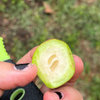Composting with store bought vegies - GM Issue?
trsinc
17 years ago
Related Stories

GARDENING GUIDESGet on a Composting Kick (Hello, Free Fertilizer!)
Quit shelling out for pricey substitutes that aren’t even as good. Here’s how to give your soil the best while lightening your trash load
Full Story
ORGANIZINGPre-Storage Checklist: 10 Questions to Ask Yourself Before You Store
Wait, stop. Do you really need to keep that item you’re about to put into storage?
Full Story
KITCHEN DESIGNIs a Kitchen Corner Sink Right for You?
We cover all the angles of the kitchen corner, from savvy storage to traffic issues, so you can make a smart decision about your sink
Full Story
PETSSo You Want to Get a Cat
If you're a cat lover, the joys outweigh any other issue. If you haven't lived with one yet, here are a few things to know
Full Story
HOUSEKEEPINGHow to Fix a Stinky Garbage Disposal
No plumber’s fee or even a trip to the hardware store is required with these easy solutions
Full Story
LIFE10 Smart Organizing Ideas That Make Life Easier
Rethink where and how you store household basics, from bills to baking supplies, to buy some time and save some headaches
Full Story
SAVING WATER6 Reasons Why You Should Save Your Rainwater Now
Collect and store during the rainy season so you’ll have water ready for irrigation when you need it
Full Story
HOUZZ TOURSMy Houzz: A Master’s Design Goes Green and Universal
Adapting $500 house plans in Pittsburgh leads to planned Platinum LEED certification and better accessibility for one of the owners
Full Story
EARTH DAYThe Case for Losing the Traditional Lawn
Work less, help the environment and foster connections by just saying no to typical turf
Full Story
HOUZZ TOURSMy Houzz: Mobile Microliving in Oregon
A 128-square-foot home for a couple in Portland is designed for simplicity, affordability and beauty
Full Story







captaincompostal
cobalt_blue
Related Professionals
Pelham Landscape Contractors · Pottstown Landscape Contractors · Cliffside Park Landscape Contractors · El Segundo Landscape Contractors · Longview Landscape Contractors · Middletown Landscape Contractors · Pueblo West Landscape Contractors · Tacoma Landscape Contractors · Woodbury Landscape Contractors · Irvington Landscape Contractors · Boynton Beach Decks, Patios & Outdoor Enclosures · Des Moines Decks, Patios & Outdoor Enclosures · High Point Decks, Patios & Outdoor Enclosures · Palmetto Decks, Patios & Outdoor Enclosures · Santa Monica Decks, Patios & Outdoor Enclosuresend3
pickwick
althea_gw
cobalt_blue
byron
gumby_ct
althea_gw
althea_gw
cobalt_blue
led_zep_rules
pickwick
trancegemini_wa
cobalt_blue
althea_gw
patty4150
trsincOriginal Author
althea_gw
pickwick
billme
billme
trsincOriginal Author
althea_gw
patty4150
pickwick
pickwick